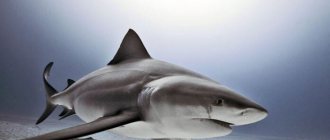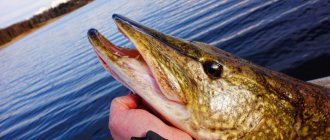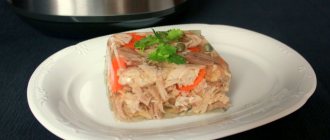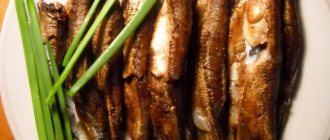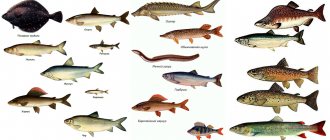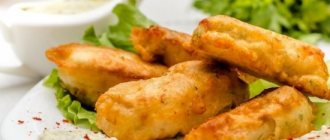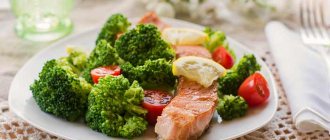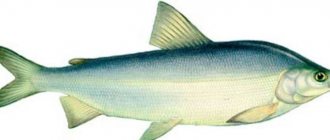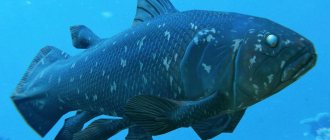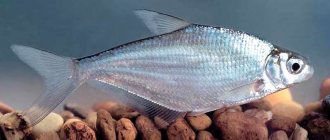What do fish eat?
For fish, all food is contained in their habitat, so living conditions, growth, and development intensity depend on the quality, quantity and nutritional value of the food supply. Fish food consists of plant and animal organisms, which must be in excess for normal nutrition. So, according to research, to gain 1 kg of weight, a pike perch should eat about 3 kg of fish, a perch - about 4.5-5 kg. The nutritional value of the feed is also of great importance for the growth of the fish. It has been noted more than once that individuals of the same species can differ radically in size and fatness depending on their habitat, even if their bodies of water are located close to each other.
Table of contents
— What do fish eat ↓ — What is plankton ↓ — What is benthos ↓ — What determines the feeding activity of fish ↓ — Plankton. What is plankton? Video under a microscope (Video) ↓
Reservoirs are replenished with food during periods of intense flooding. When nearby meadows are flooded, the reservoirs are enriched with food due to various plant and invertebrate organisms. In turn, a reduction in habitat leads to a decrease in the amount of food for all fish, regardless of species and nutrition.
Depending on the nature of their diet, adults are divided into predatory and herbivorous (“peaceful”) fish. This division can be carried out only among adult fish; at the initial stages of development, all larvae and fry feed on plankton or small animal organisms. Separation in diet according to species occurs as individuals grow older; predators are separated into a separate category, while the rest continue to feed on plankton and benthos.
Power types
All fish, depending on their gastronomic preferences, are divided into several types:
- Ichthyophages (aka predators) are a group of fish belonging to different families, the main diet of which includes smaller fish.
- Benthophages - bottom-feeding plant and animal feeders. This category includes carp, barbel, bream, tench, crucian carp, sturgeon, etc.
- Planktivores - this group feeds on plankton, which it finds in the water column. This includes bleak, verkhovka, etc.
- Bentho-planktivores are a group of fish with a mixed type of diet. This includes sabrefish, stellate sturgeon, some types of gobies, etc.
The division by type of food is somewhat arbitrary. The diet of fish varies greatly depending on their age - juveniles of predatory species feed on zoobenthos, switching to a “fish diet” at an older age. Even in old age, perch readily eats zooplankton. On the other hand, bream, carp, crucian carp, especially large individuals, are often seen eating fry. At the same time, feeding behavior is influenced by the availability of food in the reservoir . In different years, or even times of the same year, what fish eat in the river can be very different.
How does diet affect your appearance?
For greater fishing success, it is good to know what and where to catch the chosen fish. It turns out that the intended diet and habitat can be determined by their appearance. Many centuries of evolution could not help but leave their traces.
Mouth shape
The structure of the mouth determines the method of obtaining food. This is the most reliable method for determining the horizon of a reservoir where fish feed:
- Upper mouth - the lower jaw is much larger than the upper jaw. This mouth structure allows for feeding in the upper water levels. A classic example is the saberfish.
- Lower (or semi-lower) mouth - the upper jaw hangs over the lower jaw. This type of mouth structure indicates feeding in the bottom area. Sturgeon fish have a similar mouth structure.
- Retractable mouth - many carp fish are able to extend their mouth, forming a kind of tube. This feature allows them to confidently feed at the bottom of reservoirs. Examples include carp and bream.
- Terminal Mouth - Both jaws are the same length. This structure allows fish to feed in all water horizons. Such fish include omul.
Other signs
The shape of the body can say a lot about the habitat of the fish and the way it feeds. There are other features that you can pay attention to:
- Fish with a strong torpedo-shaped body tend to live in large currents. These species include trout, barbel, and chub.
- The body, which is strongly flattened laterally, indicates that the fish prefers to live among aquatic vegetation. This shape makes it easier to move around in these areas. Roach, bream, and silver bream look exactly like this.
- A highly developed dorsal fin, or even its doubling, shows that its owner is an active predator, capable of pursuing its prey for a long time. Pike perch and perch have similar fins.
- The presence of teeth on the jaws of a fish confidently indicates that it is predatory. Pike, perch, pike perch are typical examples. In addition to the jaws, some species also have teeth on the palate. Many somas have a similar structure of the oral cavity. Many peaceful species have so-called pharyngeal teeth. They give them the opportunity to grind quite serious food - mollusks, crayfish shells. The chub has excellent pharyngeal teeth, making it a real all-rounder in terms of nutrition.
What is plankton
Plankton includes small plant and animal organisms that are not attached to the bottom of a reservoir, but drift freely in the water. The plant part of plankton, consisting of tiny algae, is also called phytoplankton. Small animal organisms, also related to plankton and making up most of the biomass of a reservoir, are called zooplankton.
Phytoplankton as food is suitable for lower species of crustaceans, certain species of fish, as well as for young animals and fish in the earliest stages of development: larvae or fry. Zooplankton in fresh water bodies, as an integral part of plankton, has high nutritional value and is intended to feed animal-eating fish that feed on invertebrate organisms. Slow-flowing and shallow water bodies are rich in plankton, including ponds and lakes, which are well heated by the sun and are located on fairly fertile soils.
1. How and what do fish eat?
What do fish eat? What does she eat? If fish food is in the water, then why do we hardly see it?
Firstly, because fish find some of them at depth, under a large thickness of water - at the bottom. Secondly, because in the seemingly transparent layers of water accessible to our vision, there are many creatures that the human eye cannot distinguish or hardly distinguishes.
What do fish eat?
According to the nature of their diet, adult fish are divided into three groups: herbivorous, carnivorous and carnivorous.
Herbivorous fish feed on aquatic plants. Carnivores feed on invertebrates. Carnivores feed on fish and other vertebrates. It should be noted that this division is conditional. Peaceful carnivorous fish sometimes feed on young fish and often their own.
The larvae of some fish species, depending on the yolk supply, switch to independent feeding a few days after emerging from the eggs, others - after a few weeks. The food of juvenile fish in the early stages of life is the smallest organisms from microscopic algae and protozoa. Then comes the transition to feeding on larger organisms, mainly representatives of plankton: rotifers, crustaceans, and only later does the differentiation of fish into herbivores, peaceful carnivores and predators occur. For all fish, their feeding patterns change with age.
The feeding methods of fish are different. Some species take food primarily from the surface of the water, most feed in the middle layers, and many fish collect food from the bottom or find it by rummaging in the ground. Many of the fish are predators, obtaining food for themselves using various methods. Depending on the method of feeding, individual species in the process of evolution acquired a body shape and structure of nutritional organs that facilitate the acquisition and consumption of food. Fish that feed at the surface of the water have an elongated body, a straight line of the back and a mouth located upward, which gives them the opportunity, while maneuvering, to instantly grab an insect that has landed on the water. Bottom-feeding fish (catfish, etc.), on the contrary, have a straight abdomen, facilitating movement along the ground, and a downward-facing mouth equipped with whiskers - sensitive tactile organs for detecting food. In fish whose diet includes mainly algae (for example, mollies), the lower lip is wide, turned into a plate-like scraper, with which they carefully clear algal cover from plants.
The amount of food demand is reflected in the behavior of fish: intraspecific and interspecific competition for food is manifested. Under natural conditions, with a variety of food and its significant dispersion, the frequency of food intake varies among different fish. For the same species, the amount of food consumed varies and depends on the age of the fish, the quality of the food, the season of the year, the condition of the fish, and the concentration of feeding fish.
In fish, part of the food taken and digested goes to maintaining its vital functions: metabolism, movement, breathing. This food is called maintenance food. The larger the fish itself, the more it is required.
The food produced is used to increase the weight of the fish. At an older age, fish experience a decline in growth rate and the food they consume will be used to maintain vital functions, and not to increase their weight.
Conventionally, food in relation to it can be divided into favorite, substitute and forced. Under favorable conditions, the fish chooses its favorite food, which constitutes the main contents of the intestine. If there is a shortage or absence of their favorite food, the fish switches to a replacement diet. If there is a shortage of the latter, she eats forced food.
Most species search for food throughout the day, others feed at dusk and at night, predators can hide in shelters for a long time, waiting for prey, and, having had enough, do not resume hunting for many hours, or even days. The fish kept in the aquarium adapt to the feeding regime established by general rules developed through practical experience. In aquarium practice, the normal regimen is to feed adult fish twice a day - in the morning and in the evening. You cannot feed fish, except large predatory specimens, only once a day. The prevailing opinion among some aquarists that in order to maintain the normal condition of fish it is better to underfeed them than to overfeed them is incorrect. Fish must receive sufficient quality food on time and be well fed.
It is impossible to establish any standard norms for food consumption per fish. The amount of food consumed by fish depends on many factors. Daily food intake varies among individual species.
The feeding intensity of fish largely depends on temperature. Each species feeds most actively in a certain temperature range: goldfish at 15-20°C, angelfish 22-26°C, gourami 24-28°C. Above and below a certain temperature, fish stop feeding altogether. An increase in temperature causes the fish to digest food faster. In this regard, the intensity of food intake in fish increases at higher temperatures.
Some fish stop feeding during the spawning period and during the spawning itself. Spawning starvation leads to exhaustion, but after spawning the fish begins a period of increased nutrition. However, spawning starvation is not typical for all fish. Some fish continue to feed throughout the spawning period.
All these features in the behavior of fish and their relationship to food must be taken into account by the aquarist in order to correctly assess the fish’s need for the necessary nutrition.
Fish are living organisms, and the need for food among fish of even the same species naturally varies, not to mention the fact that fish of different species and ages are usually kept together in aquariums. It is generally accepted that if fish, having eaten food in 10-20 minutes, become blurry and do not express the desire to continue eating, then we can assume that they are full.
Main types of food for aquarium fish:
– live and animal origin: “living dust” – freshwater plankton, slipper ciliates, rotifers, daphnia, cyclops, coretra, bloodworms, “devils”, mayfly larvae, fruit flies, tubifex, enchytraeus, nematodes, grindal, earthworms, meat , eggs;
– dry: daphnia, cyclops, gammarus, bloodworms, tubifex;
– frozen: daphnia, cyclops, bloodworms;
– vegetable: semolina, lettuce, nettle, soft aquarium plants;
– compound feed.
Feeding fish is one of the most important factors when keeping fish in an aquarium. Rational feeding of fish with a variety of high-quality food containing substances necessary for the body preserves their original natural characteristics - appearance, color, resistance to disease, ability to produce
The prevailing opinion among some aquarists that in order to maintain the normal condition of fish it is better to underfeed them than to overfeed them is incorrect. Fish must receive sufficient quality food on time and be well fed.
Table of contents
What determines feeding activity in fish?
— The feeding activity of fish depends on the time of day. Most species feed in the morning and evening, plankton eaters during the day, and some predators at night; — The nutrition of fish largely depends on the environmental conditions surrounding the reservoir. A significant influence on the feeding activity of fish, and therefore on the bite, is exerted not only by the water temperature, suitable for normal living conditions of the fish, and the oxygen content; — great importance , for example, wind direction. Northern and eastern winds, causing a general cooling of air and water, can lead to a significant deterioration in the bite, to the point that it can stop completely; — Also, fish nutrition and bite depend on the state of the fish’s body: they intensify before spawning, subside during and resume after the end. Perch and ide, for example, continue to feed intensively even during the spawning period; pike and bream can begin active feeding only two weeks after the end of spawning.
Fish nutrition. How and what do fish eat?
Return to section: About the life of fish, anatomy and physiology
Based on the nature of their diet, adult fish are divided into peaceful and predatory. Peaceful ones, in turn, are divided into herbivores and carnivores. Carnivores (pike, catfish, burbot) feed on fish; animal-eaters (bream, sabrefish, crucian carp) - zooplankton, benthos; herbivores (grass carp, silver carp) - higher plants and phytoplankton.
The division is conditional. All fish, including predatory ones, feed on plankton in their youth, and all carnivores, to one degree or another, eat plant food. The proportion of plant food is especially high in rudd and roach. Predatory perch, until 8-10 years old, does not stop feeding on plankton and benthos - so to speak, peaceful food. In general, the diet of many fish is mixed and often depends on what food is available in abundance in a given body of water.
What do fish eat?
Nutritional patterns change throughout the season. In the spring, the roach's diet is dominated by insect larvae, in the summer - algae, and closer to autumn - small mollusks. At the same time, in different reservoirs (river, lake, reservoir), the nature of the seasonal dynamics of nutrition may be different. But it necessarily corresponds to the changes that the food supply undergoes throughout the season.
It is interesting that these processes are not completely repeated in different years: they say, “it doesn’t happen year after year.” That is why it is impossible, without knowing the feeding habits of fish in any particular body of water, to predict which bait it will take.
The art of the fisherman lies in the ability to quickly determine what attracts fish at the moment from the assortment of baits that are in stock.
An observant fisherman will certainly take an interest in the intestinal contents of the fish that he cleans on the ear. This often tells him a lot. An intestine that is tightly packed with food is confirmation that the fish is feeding intensively; an empty intestine often indicates a lack of food - in both cases there will be a bite. In fatty, well-fed fish, the intestines may have weak filling. The amount of a particular food that a fish eats depends on its composition and calorie content. Most fish finish feeding by the time of the autumn cold snap before the freeze-up. The higher their fatness, the fatter they are, the more successful hibernation will be. Poorly nourished fish wander under the ice in winter, becoming prey for fishermen. The widespread development of ice fishing in recent decades indicates that the sleep of fish, due to a decrease in the food supply of rivers due to pollution by wastewater, as well as due to a lack of oxygen for the same reasons, has become not very strong.
